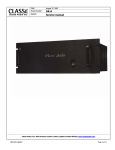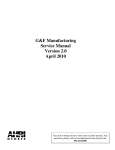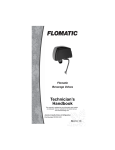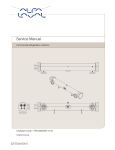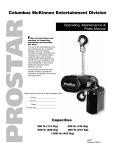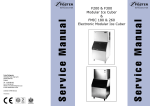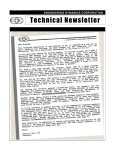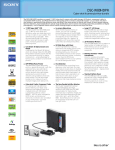Download TROUBLESHOOTING LIVESTOCK AND POULTRY VENTILATION
Transcript
TROUBLESHOOTING LIVESTOCK AND POULTRY VENTILATION PROBLEMS NEW 87:11 H.E. Huffman The ventilation system is one of the most important, yet least understood components in a livestock or poultry barn. Its main functions are to remove respired moisture, excess heat, gases, odors and dust while maintaining a comfortable, draft-free environment. This environment should provide comfort for the animals - not just for the operator. The behavior and productivity of animals are the best clues to ventilation performance; if they are comfortable, they will look and act comfortable. For example, huddling and panting are common animal reactions to temperature extremes (too cold or too hot respectively). The Canada Plan Service prepares detailed plans showing how to construct modern farm buildings, livestock housing systems, storages and equipment for Canadian Agriculture. To obtain another copy of this leaflet, contact your local provincial agricultural engineer or extension advisor. The troubleshooting tables in this leaflet describe some of the problems that occur in livestock and poultry buildings, list the possible causes and suggest remedies. One must also appreciate that ventilation problems tend to be interrelated - one problem often causes another. For example, consider the situation where a crossflow air inlet is open too wide. The main problem will be poor air distribution within the barn, but several other related problems will develop. Colder incoming air will fall to the floor very quickly, creating drafts. Temperatures may not be uniform throughout the barn and the air will become damp because the respired moisture is not being adequately mixed and exhausted through the fans. By reducing the size of the air inlet, the incoming air is jetted into the barn, creating better mixing and a good air circulation pattern. Not only has the air distribution problem been solved, but there is no longer a floor draft or uneven temperatures and more water vapor is being carried to the exhaust fan by the better mixed air. Sometimes such interrelationships can make the analysis of ventilation problems more difficult. Often you must make several changes to completely solve a problem. WHO CAN HELP? Ventilation is not a simple, exact science. Obviously, problem identification and problem solving became easier with time and experience. If you have difficulty in solving a problem, contact someone with ventilation expertise. First try the equipment supplier, who should be able to correct any equipment malfunctions. Often the equipment is installed and/or wired incorrectly; contact your building contractor and/or electrician for these types of problems. Agricultural extension engineers and power company personnel can also help. This leaflet also contains a "Ventilation Evaluation Form". Use it to record the details of the barn and its ventilation problem. This information will be essential for evaluating a particular case - especially if the ventilation consultant is not able to make an on-site inspection. You can cut this form from the leaflet and mail it to your ventilation consultant. ADDITIONAL INFORMATION can be found in other Canada Plan Service plans in the 9700 series and in Agriculture Canada Publication 1799/E, Good Energy Management in Farm Livestock Housing. TABLE 1 TROUBLESHOOTING WINTER VENTILATION PROBLEMS Problem Bad air throughout building Possible causes) Insufficient or intermittent ventilation Thermostatic controls) of continuous fans not located, set, or wired properly Insufficient heat to force continuous ventilation while maintaining building temperature Exhaust fans not protected from outside wind pressure Bad air in localized areas within building Fresh air not well distributed within building space Remedies Check fan louvres for free movement Install smaller step 1 exhaust fans to allow continuous minimum ventilation If animals can tolerate cold, reduce thermostat setpoints to increase ventilation rate Check control location for drafts or dead air pocket Check calibration (setting), using a thermometer Check that two-speed fans are switching to low speed (not high) when temperature falls Add supplemental heat to maintain temperature Install proper fan hoods, to maintain an output in spite of headwinds Adjust or add air inlet in building. This might take the form of recirculation equipment In older buildings, seal oversized cracks or holes wherever air is good TABLE 1 TROUBLESHOOTING WINTER VENTILATION PROBLEMS (CONT'D) Problem Condensation on walls or ceiling of building Possible causes) Insufficient insulation Insufficient heat to provide moisture control at desired building temperature Nearly saturated air migrating to cooler building area Large building temperature fluctuations, e.g., 5C every 10 minutes or so Building too cold, air quality good Excess ventilation: - exhaust fan capacity steps too large; - too much fan capacity per thermostat; - faulty (insensitive) thermostat; - thermostatic control not located to sense average room temperature Oversized heater Excess ventilation: - thermostatic control set too low; - exhaust rates too high Lack of insulation or heat: - over-ventilation is used to control condensation; - insufficient heat Remedies Add or replace insulation Lower building temperature and humidity by increasing exhaust rate, if animals can tolerate cooler conditions Add supplemental heat, particularly for young animals and poultry Relocate some mature animals to cooler area to raise the temperature Recirculate inside air to eliminate the temperature differential Isolate the problem area except when in use (e.g., cow holding area at milking parlor) Install lower-capacity fans) Install additional thermostatic control or switch off one fan during very cold weather Clean or replace thermostatic control Move thermostatic control away from draft or heat source affecting sensor Reduce firing rate or replace with smaller heater Readjust, clean, or replace thermostatic controls) Install one (or more) lower capacity exhaust fans Switch off one of two fans connected to one thermostatic control Calibrate thermostatic control with an accurate thermometer Step the thermostat settings to prevent over-ventilation in cold weather Insulate building to permit higher relative humidity without condensation Increase stocking density Consider conventional supplemental heating, heat exchangers, solar walls, etc. TABLE 1 TROUBLESHOOTING WINTER VENTILATION PROBLEMS (CONT'D) Problem Drafts Possible causes) Air inlet opening too wide, causing cold air to fall Obstruction on ceiling, causing cold air to fall (greatest effect in low airflow applications, e.g., furrowing and calf units) Soffit air intake not hooded or protected from wind Leaky older building, poor fitting doors and windows Mechanical air recirculation (distribution) systems that are oversized, misplaced, or misdirected Remedies Reduce inlet opening to create air jetting and mixing above animals/birds Remove obstruction or reduce effect, provide at least 1 m of smooth ceiling surface in front of air inlet Suspend conduit farther from ceiling Install corrugated metal ceiling in direction of airflow during construction Preheat incoming air in hallway Move soffit intake farther out from wall towards fascia board Restrict (close down) external air intake for winter period using a hinged door or sliding panel Draw air from attic during winter, if continuous ventilation is certain Seal excess cracks and holes Cover summer exhaust fans Consult the manufacturer's literature or contact representative for assistance TABLE 2 TROUBLESHOOTING SUMMER VENTILATION PROBLEMS Problem Air too hot throughout building, compared to outside temperature Possible causes) Insufficient air movement: - fan(s) not operating; - fan blades not set properly in orifice; - insufficient fan capacity; - fan hoods too small or obstructed; - opening to grouped fans too small for total air flow Restricted airflow from outside intake to inlets: - air intake not large enough; - warmed attic air drawn in because of insufficient air intake area Excess attic heat load to building: - insufficient attic insulation and/or ventilation; - dark (nonreflective) roof surface Excess animal density Building air too hot in specific areas Air inlets open too far, causing short circuiting to exhaust fans) or concentrated air inlet Lack of fresh air Building air hotter than desirable for the animals/birds Ambient temperature too hot for animal or bird comfort: - Birds/animals showing signs of heat stress (panting, lethargy, poor appetite) Excessive daily building temperature changes and/or draft problems Thermostatic control settings too low Remedies Replace defective controls or motor Adjust fan on shaft for one-third protrusion Add high-capacity fans or open building completely by opening doors and windows Increase fan hood size to at least two times fan area Increase wall opening or move a fan from group to other wall Increase air intake area on outside of building Increase air intake area on outside of building and ensure vertical blocking is placed between trusses Reinsulate attic and ensure adequate eave inlet and ridge or gable opening areas Consider either painting the roof white to reflect the sunlight, or installing a new roof that has a solar-reflective surface Reduce animal/bird density during summer (if practical) Reduce air inlet opening to cause jetting in all areas (close doors) Add continuous air inlet or air recirculation system Install intermittent spray-cooling system rather than increase fan capacity above normal rates, thus permitting evaporative cooling from body surfaces Use evaporative air-cooling systems if summer relative humidity is usually low. Do not insulate under concrete floors where mature animals are being housed Raise thermostat temperature settings to reflect a higher acceptable room temperature during warm weather







